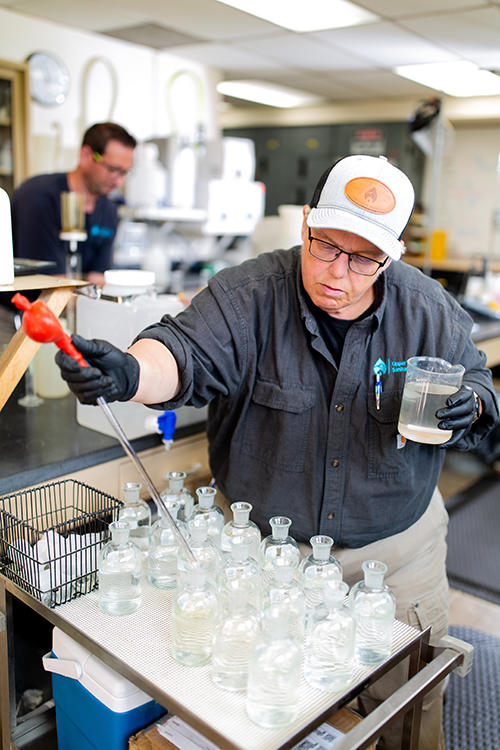Treatment
Preliminary Treatment
Approximately 96 miles of collection and interceptor lines carry the sewage by gravity to two lift stations. The wastewater flow to the plant is pumped through these two lift stations with a combined pumping capacity of 9.72 MGD. The flow goes from the two lift stations to a Flow Equalization Basin to allow proportional flow rates into the plant, leveling out the high peak flow periods of the day. The Equalization basin has a capacity of 325,000 gallons and employs a scraper mechanism on the bottom to prevent the accumulation of solids. Flow is controlled from the Equalization Basin with a pinch valve before entering a Grit Chamber, designed to allow additional settling of solids such as rocks, sand, and eggshells as well as other inorganic solids. In order to achieve this, the flow of the influent must be reduced to one foot per second. These solids are removed as needed with a Vacuum Truck and disposed of at a sanitary landfill. A Cippoletti weir follows the Grit Chamber for influent flow measurement.
Secondary Treatment
Four Aeration Basins follow the Preliminary Treatment processes and provide the bulk of the actual treatment process of pollutants. These basins, with a capacity of 238,000 gallons each, are a suspended growth biological process called Activated Sludge. Bacteria and other microbiological organisms within the Activated Sludge use the organics within the sewage as a food source, thus breaking down the sewage. Dissolved free oxygen must also be added in order to produce an environment conducive to the microorganisms and to keep the contents of the basins well mixed. The Activated Sludge then flows to the Secondary Clarifiers where the biosolids settle out, leaving a clear supernatant on top.
A revolving arm removes the scum from the top of the Clarifier and a collection arm collects the sludge from the bottom of the tank. The sludge that settles in the Clarifier is returned back into the Aeration Basin to provide a proper balance of biological organisms to the organic loading of the plant. The remaining sludge is pumped to Aerobic Digesters for further treatment and ultimate disposal. 90-95% of the suspended solids and biochemical oxygen demand (BODs) are removed through this secondary process.
Tertiary Treatment
This facility was built with two Tertiary treatment processes, a Nitrification Tower and Media Pressure Filters. The Ammonia Towers are employed for ammonia removal with the use of fixed-film biological media. Redwood and plastic media develop a zoeal growth, which strips the wastewater of the ammonia nitrogen. The microorganisms contained in this media use ammonia as a food source, similar in theory to the secondary process. For final polishing of the affluent, the flow passes through Tri-Media Pressure Filters. These filters contain layers of Anthracite, sand, and garnet, which trap the very fine suspended solids in the effluent water. When these pressure filters begin to lose efficiency as a result of a buildup of suspended solids, water from the final discharge basin is used to backwash them, pushing the solids out. The water from these backwashes is pumped back to the front of the plant to be mixed with the incoming flow.
Disinfection
Disinfection is necessary before discharging into the Big Thompson River. Chlorination and Dechlorination are used for the disinfection of the plant effluent from the Tertiary treatment process. Chlorine is a simple, effective, as well as a cost-effective way to disinfect the effluent. Sodium Hypochlorite (10% solution) is used to kill possible pathogens and Sodium Bisulfate is then added to neutralize the chlorine.
Sludge Handling
The Digesters receive wastewater sludge that has gone full cycle through the treatment process, high in nitrogen, phosphorus, and potassium. This sludge is removed (aka wasted) from the treatment process to be ultimately disposed of at an approved landfill. The UTSD Treatment facility uses Aerobic Digesters to further break down the organics within the sludge and produce a less beneficial product. These Digesters have a capacity of 476,000 gallons collectively and are identical in construction to the Aeration Basins. The water is separated from the sludge by a Centrifuge System where the water is returned to the headworks and remaining solids are hauled away to a land application, as per the 503 Regulations.
Laboratory Analysis
The laboratory is equipped for all analyses as required for operation, regulated by the EPA and the Colorado Department of Public Health and Environment. Operational control tests are run on a daily basis as well as testing at specified periods for ph, fecal coliforms, chlorine residual, suspended solids, volatile solids, biochemical oxygen demand, nitrogen ammonia, phosphorus, nitrates, and alkalinity.
Planning for the Future
The District must focus on the future and plan accordingly to face the changes in regulations, technology, and equipment life span. Federal and State regulations will change possibly becoming stricter, such as Regulation 31. The technology of wastewater continues to improve allowing better process control and return on investment.


